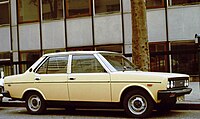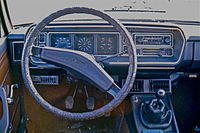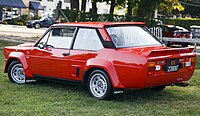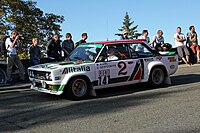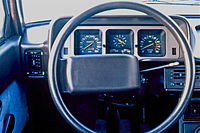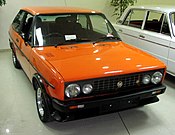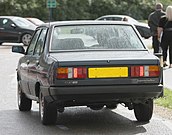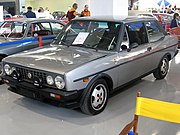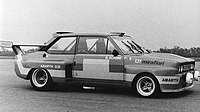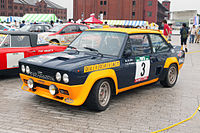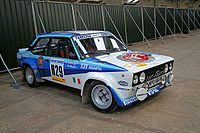Fiat 131
 From Wikipedia the free encyclopedia
From Wikipedia the free encyclopedia
| Fiat 131 | |
|---|---|
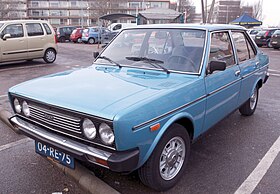 Fiat 131 (Series 1) | |
| Overview | |
| Manufacturer | Fiat |
| Also called |
|
| Production | 1974–1984 |
| Assembly | |
| Body and chassis | |
| Class | Family car |
| Body style | |
| Layout | Front-engine, rear-wheel-drive |
| Related |
|
| Powertrain | |
| Engine |
|
| Transmission | |
| Dimensions | |
| Wheelbase | 2,490 mm (98.0 in)[6] |
| Length | 4,230 to 4,264 mm (166.5 to 167.9 in)[6] |
| Width | 1,644 to 1,651 mm (64.7 to 65.0 in) |
| Height | 1,381 to 1,411 mm (54.4 to 55.6 in) |
| Kerb weight | 950 to 1,145 kg (2,094 to 2,524 lb) |
| Chronology | |
| Predecessor | Fiat 124 |
| Successor | Fiat Regata |
The Fiat 131 is a mid-size family car manufactured and marketed by Fiat from 1974 to 1984 after its debut at the 1974 Turin Motor Show. Available as a two-door and four-door saloon and 5-door estate across a single generation, the 131 succeeded the Fiat 124.
The 131 was also marketed as the Fiat Mirafiori, after the Turin district where the cars were manufactured. Initially, the 131 was offered with 1.3 L and 1.6 L overhead valve engines and the range received revisions in 1978 and 1981. Production reached 1,513,800.[5]
Specifications
[edit]The Fiat 131 used steel monocoque bodywork for its three-box design and used a front engine, rear-wheel drive layout, where the engine is longitudinally front-mounted. The gearbox is directly behind the engine, and a tubular propeller shaft, under the transmission "tunnel", transmits the drive to a solid live rear axle.
The engines were all inline-four types, derived from those used in the outgoing 124 range, with a cast iron cylinder block and aluminium alloy cylinder head. Initially the 131 was offered only with pushrod valve gear, which offered the innovation of being the worldwide first engine with OHV valve gear and a belt driven camshaft. Only later in the model's life came the well known double overhead camshaft (DOHC) engines which used a toothed timing belt. Fuel supply was via a single Weber ADF twin-choke carburettor, fed from a trunk mounted steel fuel tank. Traditional contact breaker ignition systems were used, usually with Marelli distributors.
The suspension system utilised fully independent front suspension, with MacPherson struts, track control arms and anti-roll bar. The rear suspension was quite advanced (when using a solid live rear axle), in that the rear axle was controlled by double unequal length trailing arms and a panhard rod, with coil springs and direct acting dampers. This design proved far superior to many of its contemporaries, especially with respect to vehicle stability and handling.
The braking system was also typical; the front brakes were disc brakes, using a solid iron disc and a single-piston sliding caliper. The rears were drum brakes (a technological backwards step from the 124, which used discs all round), utilising leading and trailing shoe design operated by a dual piston fixed slave cylinder. They were operated hydraulically, with a tandem master cylinder assisted by a vacuum servo using two separate circuits. A rear-mounted load sensing valve varied the bias of effort applied to the rear brakes, dependent on the load being carried (and also the pitch dynamics caused by braking effort and road levels). A centrally located floor mounted handbrake operated on the rear axle using bowden cables.
The car's interior had its secondary dashboard switches illuminated by a central bulb with fibre optic distribution to the switches.
Series 1 (1974–1978)
[edit]The Fiat 131 Mirafiori was introduced at the 55th Turin Motor Show in late October 1974.[7] The 131 came with a choice of a 1,297 cc (1.3 L) or 1,585 cc (1.6 L) OHV inline-four engines, both from the engine family first introduced on the Fiat 124. Both engines were fitted with a single twin-choke Weber 32 ADF downdraught carburettor. A 4-speed manual transmission was standard, with a 5-speed manual and a 3-speed torque converter automatic optional on the 1600 engine only.
The initial range comprised eleven different models.[7] There were three body styles, all available from the start: 2-door saloon, 4-door saloon and Familiare station wagon (Estate on the British market).[8] Trim levels were two; the entry-level 131 Mirafiori (also known as "Normale" or "Standard") had single square headlamps, wheels and dished hubcap from the 124, and simplified interior furnishings. Next was the better appointed 131 Mirafiori Special (or simply "S"), which could be distinguished from the base model by its quadruple circular headlamps, specific grille, side rubbing strips, chrome window surrounds, and rubber bumper inserts.[7] Inside it added different instrumentation with triple square dials, a padded adjustable steering wheel, cloth upholstery, and reclining seats.[7] Additionally the more sophisticated options — such as air conditioning, tachometer, limited slip differential and vinyl roof — were exclusive to the Special. Each body style could be combined with either of the engines and trim levels, save for the Special estate which only came with the larger engine.
Initial sales were disappointing, since the car was launched at the height of the oil crisis and at a time of strikes and hyperinflation at home. Adding to manufacturers' woes, the cost of parts and materials all increased, while sales went down. Gradually, however, sales built up and the car also sold well in export markets. In 1975, the 131 went on sale in the United States as well. US market versions had a SOHC 1.8 litre inline-four, carried over from the earlier 124 but now with more emissions control equipment, and were available with a GM three-speed automatic transmission.[9]
Salvatore Diomante's Autocostruzioni S.D., located near Turin, offered a nearly 5-metre long "131 Diplomatic" limousine conversion.[10]
Model Engine code Engine type Displacement
bore × strokeCarburetor Power Mirafiori 1300N 131A6.000[11] OHV I4 1,297 cc (1.3 L)
75.0 × 71.5 mmsingle twin-choke
Solex C32 TD155 PS DIN (40 kW; 54 hp) at 5000 rpm
(Germany-only version for low octane fuel use)Familiare 1300N Mirafiori 1300 131A.000[12] single twin-choke
Weber 32 ADF65 PS DIN (48 kW; 64 hp) at 5400 rpm Mirafiori Special 1300 Familiare 1300 Mirafiori 1600 131A1.000[12] 1,585 cc (1.6 L)
84.0 × 71.5 mm75 PS DIN (55 kW; 74 hp) at 5400 rpm Mirafiori Special 1600 Familiare 1600 Familiare Special 1600 Abarth Rally[13] 131AR.000 DOHC 16-valve I4 1,995 cc (2.0 L)
84.0 × 90.0 mmsingle twin-choke
Weber 34 ADF140 PS DIN (103 kW; 138 hp) at 6400 rpm US version 131A1.040 SOHC I4 1,756 cc (1.8 L) single twin-choke
Weber86 hp SAE net (64 kW; 87 PS)[9]
CA: 83 hp SAE net (62 kW; 84 PS) at 5800 rpm[14]
- Fiat 131 Mirafiori Special
- The T-shaped tail lamps are characteristic of first series cars.
- Series 1 dashboard, here a Mirafiori Special's
- SEAT 131 Estate
- US-spec 1976 Fiat 131 four-door, showing the larger bumpers used to meet strict federal safety standards.
Fiat 131 Abarth Rally
[edit]In 1976, 400 examples of the Fiat 131 Abarth Rally were built for homologation purposes.[15] These cars were built in a cooperation between Fiat, Bertone and Abarth. Abarth and Bertone had the strict order to stay as close as possible to the base model, both in parts choice and in physical appearance.[16] Bertone took part-completed two door standard bodyshells from the production line in Mirafiori, fitted plastic mudguards front and rear, a plastic bonnet and bootlid and modified the metal structure to accept the rear independent suspension. The cars were fully painted and trimmed and then delivered back to the Fiat special Rivalta plant where they received the Abarth mechanicals.
The street version of the car used a DOHC 4 valves per cylinder derivative of the standard twin cam inline-four engine, equipped with a double downdraught 34 ADF Weber carburetors producing 140 PS (138 bhp; 103 kW) at 6400 rpm and 172 N⋅m (127 lb⋅ft; 17.5 kg⋅m) of torque[17] at 3600 rpm. The street cars used the standard gearbox with no synchromesh (Rally type regulations required the use of the same type of synchromesh on the competition cars as on the street versions) and stock front brake discs, which performed better because the redesigned Bertone front and hood allowed for more air to cool them. The rear wheels had brake discs instead of the stock drums.[18] Competition cars used dry sump lubrication and eventually Kugelfischer mechanical fuel injection. In race specifications, the engine produced up to 240 PS (237 bhp; 177 kW) in 1980, being driven to World Championship status by Walter Röhrl. 7212703
- Fiat Abarth 131 Rally
- Fiat 131 Abarth Rally Stradale; rear view
- Fiat 131 Abarth Rally Stradale interior
- Fiat Abarth 131 left side view
- Walter Röhrl's Fiat 131 Abarth (Sponsor Alitalia)
Series 2 (1978–1981)
[edit]The 131 got a minor facelift in 1978. New DOHC, or "Twin Cam" (TC) engines arrived, and these models were badged as Supermirafiori. The biggest changes exterior-wise for the Series 2 were larger rectangular shaped front lights (quad round headlights in the US), new bumpers (for the Supermirafiori), new bigger rear lights, while a new interior (CL, Supermirafiori) included the dashboard and a chunky, single-spoke steering wheel.
Also in 1978, the 2-door sporting version Racing (Mirafiori Sport in the UK) with 115 PS (85 kW) twin cam engine, was launched. This car had four round headlights (the inner headlights being smaller than the outer ones, unlike any other Mirafiori model produced), different grille, spoilers and extended wheel arches, and a short-throw 5 speed gearbox. The Racing had top speed of 180 km/h (110 mph). An important introduction for the Italian and many other continental European markets was the new diesel engined versions, built in Sofim's brand-new factory in Foggia.[19] The diesel had been previewed and tested in competition already, with three diesel-engined cars prepared by Abarth for the 1977 London–Sydney Marathon rally.[19] As introduced on the Series 2, 131 Diesels received four, equally sized round headlights and a noticeable (and characteristic) bump in the hood to accommodate the taller engine. The Familiare (estate) was renamed Panorama.
In Venezuela, the 131 Series 2 was kept in production after the Series 3 had been introduced in Europe. They were only available with the four-door sedan bodywork, as the Mirafiori L and the Mirafiori CL, and were fitted with the Panorama's OHV 1.6-liter engine with 75 PS (55 kW; 74 hp). An additional version was the sporting "131 Corsa 95", which used the 131 Racing's front spoiler, grille, rear spoiler, and other parts (still with four doors) along with the twin cam Supermirafiori engine and a sizable bonnet scoop. In Venezuela, this engine produced a claimed 95 PS (70 kW; 94 hp) at 6000 rpm.[20]
Brava (USA)
[edit]The Series 2 was marketed in the United States as the Fiat Brava (two-door only) and Super Brava from mid-year 1978 with the same 1.8 litre four as had been used in the US-market 131, but before the year was over this was replaced by the somewhat more powerful and much torquier 2 litre twin-cam four also seen in the Spider.[21] Initially, the better equipped models were sold as Super Bravas, but the base model and "Super" tag were dropped for 1979. The interim Brava version also retained the 131's interior.[22] Importantly, the air conditioning system was also upgraded to cope with the demands of US drivers. For 1980 a more powerful fuel-injected version was added (102 hp or 76 kW) while the Estate version was dropped. For 1981 the EFI engine became standard equipment and the headlamps were changed for single rectangular units, but this was to be the last year for the Brava/131 in the US.[23] The January 1991, edition of Popular Mechanics in the United States listed the 1979 Fiat 131 in the "Overall Worst" category as the most "trouble prone" car ever recorded in their Owner Report histories.[24]
| Displacement | Engine type | Power | |
| Mirafiori | 1297/1301 cc | I4 ohv | 65 PS (48 kW; 64 hp) |
| Supermirafiori | 1297/1301 cc | I4 dohc | 78 PS (57 kW; 77 hp) |
| Supermirafiori | 1585 cc | I4 dohc | 96 PS (71 kW; 95 hp) |
| Panorama | 1297/1301 cc | I4 ohv | 65 PS (48 kW; 64 hp) |
| Panorama | 1585 cc | I4 ohv | 75 PS (55 kW; 74 hp) |
| Diesel | 1995 cc | I4 | 60 PS (44 kW; 59 hp) |
| Diesel | 2445 cc | I4 | 72 PS (53 kW; 71 hp) |
| Racing | 1995 cc | I4 dohc | 115 PS (85 kW; 113 hp) |
| Brava | 1756 cc | I4 dohc | 83 hp (62 kW; 84 PS)[25] |
| Brava | 1995 cc | I4 dohc | 86 hp (64 kW; 87 PS) CA: 80 hp (60 kW; 81 PS)[26] |
| Brava EFI | 1995 cc | I4 dohc | 103 PS (76 kW; 102 hp)[23] |
- Fiat 131 Supermirafiori
- Series 2 dashboard
- Fiat 131 Racing
- Fiat 131 Marengo, van version of the 131 Panorama estate
131 Hybrid
[edit]In 1979, Fiat presented the 131 Ibrida,[27] an experimental prototype featuring the small 903 cc engine from the Fiat 127, de-tuned to 33 hp (24 kW), and mated to a 24 kW DC electric motor. Power is also provided by regeneration via the braking system. The 250 amp batteries are located in the boot, adding 175 kg (386 lb) to the weight.[28]
Series 3 (1981–1984)
[edit]The 131 was updated again in March 1981.[29] By this time, the car was no longer offered in the USA. Production of the Racing/Sport versions ceased, although these were sold well into 1982. The same 2.0 TC (twin cam) engine went to the Supermirafiori. The car was renamed 131 Super Brava in Australia. The car received a slightly updated interior (instruments, single-piece glovebox lid), whilst lower rubbing strips found their way onto all models up to CL specification. The Supermirafiori received larger lower door cladding. Mechanically, Mirafiori versions now received overhead cam engines rather than pushrod versions; a new 1.4 litre engine and a revised 1.6 litre. Also new were the clutch and gearboxes, a tweaked suspension was also introduced and the gas tank increased in size by three litres, for a total 53 L (14.0 US gal; 11.7 imp gal) capacity.
In June 1981, a new sport version, the Volumetrico Abarth, was introduced to some markets, with a supercharged version of the familiar 2-litre twin-cam. This car, also known as the 2000 TC Compressore, was built in a small series (about 200 units[30]) and could reach 190 km/h (118 mph).[31]
In 1983, the production of the saloon version was discontinued, but the estate, now named 131 Maratea, remained in production with two engine choices (115 PS 2.0 TC and 72 PS 2.5 D) until 1984, when they were replaced with the Ritmo-based Regata Weekend. These last versions featured four round headlights and the by-now familiar five-bar grille.
In Australia the saloon was also updated for a final time for the 1984 model year. It also received the 4 round headlight and five bar grille. Other subtle revisions were also made to the vehicles wiring with the central locking button removed and integrated into central locking motors. Wheels were upgraded to a 14-inch size with unique offset . Driveshaft universal joint size was increased . Steering rack ends and tie rod ends were sizing was also changed. Brake master cylinder bore size was increased to 20mm and brake fittings changed to a metric fine thread size.
| Model | Displacement | Engine type | Power |
| Mirafiori | 1,367 cc | SOHC I4 | 70 PS (51 kW; 69 hp) |
| Mirafiori CL | 1,585 cc | SOHC I4 | 85 PS (63 kW; 84 hp) |
| Supermirafiori | 1,367 cc | DOHC I4 | 75 PS (55 kW; 74 hp) |
| Supermirafiori | 1,585 cc | DOHC I4 | 98 PS (72 kW; 97 hp) |
| Supermirafiori | 1,995 cc | DOHC I4 | 115 PS (85 kW; 113 hp) |
| Volumetrico Abarth | 1,995 cc | DOHC I4 | 140 PS (103 kW; 138 hp) |
| Panorama | 1,301 cc | OHV I4 | 65 PS (48 kW; 64 hp) |
| Panorama | 1,585 cc | SOHC I4 | 85 PS (63 kW; 84 hp) |
| Mirafiori 2000 Diesel | 1,995 cc | I4 | 60 PS (44 kW; 59 hp) |
| Mirafiori 2500 Diesel | 2,445 cc | I4 | 72 PS (53 kW; 71 hp) |
| Supermirafiori 2500 Diesel |
- Profile of a 131 Supermirafiori Diesel 2500
- Fiat 131 Supermirafiori, rear view
- Fiat 131 Volumetrico Abarth
Motorsport
[edit]The 131 as a rally car
[edit]Fiat 131 Rally's precursor the 3.5-litre Group 5 Abarth SE 031 won 1975 Giro d'Italia automobilistico. The Fiat 131 Abarth was a very successful group 4 rally car, winning the manufacturers' World Rally Championship three times: in 1977, 1978, and in 1980. With this car Markku Alen won the 1978 FIA Cup for Drivers and Walter Röhrl won the 1980 drivers' World Rally Championship.[32] Between 1976 and 1981 the Fiat 131 won 20 WRC events; other notable drivers were Sandro Munari, Timo Salonen, Attilio Bettega and Michèle Mouton.
Between 1975 and 1977 the official "works" cars carried the Olio Fiat blue and yellow livery, then during 1978 and 1979 seasons they were sponsored by Italian airline Alitalia and bore their distinctive red, white and green livery.
Prior to the introduction of the 131 Diesel, Fiat had Abarth prepare three diesel-engined cars with two-door, Series 1 bodyshells for the 1977 London–Sydney Marathon rally to promote its reliability and robustness.[19] Entered by the French Esso Aseptogyl team, two cars finished, in 15th and 23rd place. The engines were largely unmodified, while the cars were fitted with 5-speed gearboxes and 90-litre (20 imp gal) fuel tanks.[19]
- 1975 "031", Fiat Abarth 131's pre-series racing prototype.
- Giorgio Pianta's Fiat Abarth 031, in action at the Imola stage of 1975 Giro d'Italia.
- Fiat Abarth 131 rally car with "Olio Fiat" livery
- Fiat Abarth 131 rally car with "Alitalia" livery
- Fiat Abarth 131 rally car with "Wreath Fiat" livery
World Rally Championship event victories
[edit]Fiat Abarth 131s recorded victories in the following World Rally Championship events:
Other motorsports
[edit]In 1978, American actor James Brolin campaigned a Fiat 131 Abarth on a limited schedule in the GTU category of the IMSA GT Championship. The car carried sponsorship from Anheuser-Busch Natural Light beer, which had been introduced the previous year.
Non-Italian 131 variations
[edit]
SEAT 131
[edit]
The SEAT 131 started its production in early 1975 in Barcelona with two versions initially offered: SEAT 131 L, featuring rectangular front lamps, 1,438 cc OHC engine and 4 speed gearbox and SEAT 131 E featuring four round headlamps, 1,592 cc DOHC engine and 5 speed gearbox. The range grew up in 1976 with the SEAT 131 Familiar, estate version offered with both engines. In 1977 the 131 Automatico (Automatic gearbox) was released and the following year a very short production of the SEAT 131 CLX 1800 was offered.
In 1978, the SEAT 131 evolved into the SEAT 131 Mirafiori/Supermirafiori (Panorama for the estate versions), with the same changes as seen on its Italian cousin. The engines remained largely the same, but a 1.8 litre Diesel Perkins 4.108 engine was available in 1979.
A further CLX special edition was launched in 1980. Available only in metallic silver or metallic bronze colours, this 131 CLX had a 1,919 cc engine, developing 114 PS (84 kW) at 5,800 rpm.[33]
In 1981, the Diesel version was developed with a new Sofim engine. This 2,500 cc engine was much more powerful than the Perkins version (72 hp against only 49 hp) and was one of the most successful taxis in early '80s Spain.
In 1982, the SEAT 131 changed again, gathering all the body changes seen on the Fiat 131 series 3. The 131 was now available in CL, Supermirafiori and Diplomatic versions. The Diplomatic was the top of the range, with a 1,995 cc engine and features such as power steering, power windows or air conditioning. The Panorama versions were the cars chosen by the "Cuerpo Nacional de Policia" (Spanish Police force) as patrol cars.
In 1984, the SEAT 131 range was discontinued, without a direct substitute and the Fiat Ritmo-based SEAT Málaga took its place in 1985.
Murat 131
[edit]Turkish Automotive Factories Incorporated (Tofaş) in Turkey started the production of Fiat 131s built under Fiat license with the Murat 131 (Turkish: Desire) nameplate. Later, Fiat 131 based "Bird Series" were developed and built in Bursa, Turkey. The base version of "Bird Series" was named as Murat 131 Şahin (Turkish: Hawk), luxury version was as Murat 131 Doğan (Turkish: Falcon) and the estate version was named as Murat 131 Kartal (Turkish: Eagle). These vehicles enjoyed a very long production run (1986–2002 at Turkey, 1991–2009 at Egypt, 2006–2010 at Ethiopia), and were later replaced by newer Fiat models.
Polski Fiat 131p
[edit]Assembly of the 131 sedan was also undertaken in Poland by Fabryka Samochodów Osobowych (FSO) in the years 1975 to 1981, and 3102 were assembled in total.[34] They were often used by state institutions and communist party officials.[34] First series cars were available only in Special trim and were called Polski Fiat 131p Mirafiori. Cars of second series were known under the name Fiat 131p Mirafiori and were offered in L and CL trim levels.
Other producers
[edit]The Fiat 131 was also produced at Helwan, in Egypt, by El Nasr since at least 1982,[35] on the basis of complete knockdown (CKD) kits. This was followed by CKD assembly of the Tofaş Murat 131 between 1991 and 2009. The Tofaş Murat 131 has also been assembled in Ethiopia by Holland Car between 2006 and 2010.
Other CKD production of the Fiat 131 has taken place in the following countries:[35]
- Córdoba; Argentina, FIAT Córdoba.
- Bogotá, Colombia; (Compañía Colombiana Automotriz).
- San José, Costa Rica (S.A.V.A.).
- Jakarta, Indonesia (P.T. Daha Motor, Saloon and Station Wagon).[2]
- Kuala Lumpur, Malaysia.[36]
- Casablanca, Morocco (SOMACA).
- Lisbon, Portugal (Fiat Portuguesa SARL, Somave Sarl[37])
- Singapore (Sharikat Fiat Distributors).
- Bangkok, Thailand (Karnasuta General Assembly Co.).
- Caracas, Venezuela (FIAT de Venezuela C.A.).
- Livingstone, Zambia (Livingstone Motor Assemblers Ltd)
References
[edit]- ^ Los años tenebrosos del sector automotor: 1982, El "Boom" de los Importados: Los años tenebrosos del sector automotor: 1982, El "Boom" de los Importados, accessdate: 12. July 2019
- ^ a b Mastrostefano, Raffaele, ed. (1985). Quattroruote: Tutte le Auto del Mondo 1985 (in Italian). Milano: Editoriale Domus S.p.A. p. 333. ISBN 88-7212-012-8.
- ^ "Somaca Casablanca". Somaca.e-monsite.com. Archived from the original on 20 May 2015. Retrieved 19 April 2010.
- ^ "FSO Warsaw". fso-sa.com.pl. 22 November 2011. Archived from the original on 9 February 2015. Retrieved 22 November 2011.
- ^ a b "Fiat 131". carsfromitaly.net. Retrieved 3 October 2007.
- ^ a b Auto Katalog 1983. Stuttgart: Vereinigte Motor-Verlage GmbH & Co. KG. 1982. pp. 220–221.
- ^ a b c d Villare, Renzo (30 October 1974). "Queste le undici versioni della Fiat "131 mirafiori"" [These are the eleven Fiat "131 mirafiori" variants]. La Stampa (in Italian). p. 13. Retrieved 15 November 2015.
- ^ Quattroruote: Tutte le Auto del Mondo 77/78. Milano: Editoriale Domus S.p.A. 1977. pp. 191–194.
- ^ a b Flammang, James M. (1994). Standard Catalog of Imported Cars, 1946–1990. Iola, WI: Krause Publications, Inc. p. 239. ISBN 0-87341-158-7.
- ^ Costa, André; Fraichard, Georges-Michel, eds. (1981). "Salon 1981: Toutes les Voitures du Monde". L'Auto Journal (in French) (14–15). Paris: 200.
- ^ Technische Tabellen: Fiat 131/1300 (in German), Fiat Kundendienst, January 1975, archived from the original on 30 January 2024 – via italo-youngtimer.de
- ^ a b Fiat 131 Mirafiori—Uso e manutenzione (owner's manual) (in Italian). Fiat. November 1974.
- ^ "Fiat Abarth 131 Rally—La guida pesante" [Heavyweight driving]. Autosprint (in Italian). XVI (12): 52–54. 12 March 1976.
- ^ "Fiat 131: Larger and more practical, but still sporty". Road & Track. Vol. 27, no. 3. October 1975. p. 47. Archived from the original on 28 October 2023 – via Curbside Classic.
- ^ Robson, Graham (2008). Fiat 131 Abarth. Veloce Publishing Ltd. p. 21. ISBN 978-1-84584-182-9.
- ^ De Jong, Nico (27 March 1976), "Rij-impressie Fiat Abarth 131 Rally" [Driving impression Fiat 131 Abarth Rally], Autovisie (in Dutch), Misset Amersfoort, pp. 56–57
{{citation}}: CS1 maint: date and year (link) - ^ "1978 Fiat Abarth 131 Rally". automobile-catalog. Retrieved 8 July 2018.
- ^ All the Fiats. EditorialeDomus. 1996. p. 572.
- ^ a b c d "Fiat 131 Mirafiori: da 3 anni è un successo" [Fiat 131 Mirafiori: a three-year success]. Quattroruote: Tutte le Auto del Mondo 77/78 (in Italian). Milano: Editoriale Domus S.p.A. 1977. p. 205.
- ^ Quattroruote: Tutte le Auto del Mondo 82/83: AC-Nissan (in Italian). Vol. 1°. Milano: Editoriale Domus S.p.A. 31 October 1982. p. 249.
- ^ Flammang, Standard Catalog of Imported Cars, p. 240
- ^ "Fiat Super Brava: Bravado or Bravura?", Road & Track's Road Test Annual & Buyer's Guide 1979, Greenwich, CT: CBS Publications, p. 139, January–February 1979
- ^ a b Flammang, James M. (January 1992). Standard Catalog of Imported Cars (1st ed.). Minneapolis, USA: Motorbooks Intl. pp. 241–242. ISBN 978-0873411585.
- ^ Lamb, Michael (January 1991). "Ask the Man Who Owns One "All Time Worst"". Popular Mechanics.
- ^ R&T Buyer's Guide 1979, pp. 140–141
- ^ Braunschweig, Robert; Büschi, Hans-Ulrich, eds. (6 March 1980), Automobil Revue '80 (in German and French), vol. 75, Berne, Switzerland: Hallwag, AG, p. 287
- ^ Kla, Giancarlo Gnepo (15 January 2020). "Fiat 131 ibrida: un'occasione mancata" [Fiat 131 Ibrida: A missed occasion]. Ruoteclassiche (in Italian). Retrieved 13 July 2022.
- ^ Norbye, Jan P. (November 1980). "We drive Fiat's experimental hybrid electric car". Popular Science. Vol. 217, no. 5. pp. 84–86.
- ^ Salon 1981, p. 170
- ^ "The Fiat 131 Supermirafiori Volumetrico Abarth". 131mirafiori.com. Retrieved 29 November 2012.
- ^ Büschi, Hans-Ulrich, ed. (10 March 1983). Automobil Revue '83. Vol. 78. Berne, Switzerland: Hallwag, AG. pp. 289–290. ISBN 3-444-06065-3.
- ^ "Walter Röhrl". rallybase.nl. Retrieved 3 July 2007.
- ^ Automobil Revue '80, p. 472
- ^ a b Podbielski, Zdzisław (2019). Samochody montażowe z Żerania, "Auto Świat Classic" Nr 4/2019, p. 136–137 (Polish)
- ^ a b World Cars 1982. Pelham, NY: The Automobile Club of Italy/Herald Books. 1982. p. 403. ISBN 0-910714-14-2.
- ^ Tutte le Auto del Mondo 77/78, p. 197
- ^ World Cars 1984. Pelham, NY: L'Editrice dell'Automobile LEA/Herald Books. 1984. p. 403. ISBN 0-910714-16-9.
